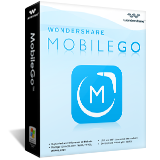iPhone VS Android: Which One You Like Better?
Just get tired of Android phone and jump ship to iPhone? I guess you probably don't want to leave any scrap of your important personal data behind? Here's how to pack up everything, like contacts, music, photos, SMS, and more from Android to iPhone without any hassle. Just read on.
| Aspects | Android phone | iPhone |
|---|---|---|
|
Battery Life
|
Because of the variety of hardware used in different Android phones, the battery life varies. Some last a long time, while some need to be charged every a couple of hours, especially when you play games. Learn more about How to save battery life>> |
It's hard to say whether iPhone battery life is longer than Android phone. If you do nothing but just keep iPhone powered, it can last for a long time. However, if you play apps, watch movies, your iPhone will lose its battery charge very quickly. Tips on how to extend iPhone battery>> |
|
Buttons & Home Screen
|
Buttons Generally, besides power button, Audio volume up and down button, the Android phone has another 3 buttons. They're the main button, left menu button and right back button. Home Screen Android phone has its main screen in the center, and you can page through left or right. One ingenious design is that Android phone has widgets, which lets you quickly scan what features you have on Android phone. |
Buttons Unlike Android phone, iPhone only has a main button except the power button and audio voice up and down button. If you get used to using an Android phone, you may feel inconvenient after switching from Android to iPhone. Home screen iPhone's home screen is a bit different from Android phone's. When you slide your finger from left to right to unlock your iPhone, the iPhone home screen will be shown on the left. You can slide right to left to access other screens. Additionally, you must realize that the iPhone doesn't have any widgets. |
|
Default App & App Update
|
Default Apps When comes to the default apps, Android phone gives you free access to choosing your wanted apps to be the default without rooting. App update On your Android phone, you can have app updated automatically. It's really convenient and time-saving. |
Default Apps Sadly, a big shortcoming that iPhone has is that Apple just want its own apps to be default, like Safari browser, mail app, map app. To set non-Apple apps as default, you have to jailbreak your iPhone. Here is how to jailbreak your iPhone>> App update Another shortcoming that lets you down is that apps on the iPhone can't be upgraded automatically. Instead, when you have app to be updated, you will see a number in red on top of the App Store app. Go to the App Store app and tap Updates to have your wanted apps to be updated. Here is a list of 17 best free iPhone apps>> |
|
Notification
|
When you get notifications, like a message, a missing phone call or others, you can drag the screen from top to down. To view the notification, you just tap it. If you don't want it, you can long tap it and slide it from left to right. |
The iPhone notification center is similar to Android phone. You can just swipe down from the top of the screen to view any notification shown there. |
|
Phone to PC Transfer
|
Android open nature offers you easy access to its SD card. You can transfer music, video, photos, contacts and documents to and from an Android phone effortlessly. | Unlike Android phone, Apple only lets you to export Camera photos to computer. To import/export other data, like music, video, you have to rely on iTunes or some third party tools. |
|
OS Update
|
Every Android version comes out, followed by some shiny new phones. However, it takes a long time for you to go through wireless carrier before the updates are approved. | Compared Android phone, iPhone iOS update turns out to be very easy. When there is a new version, you will find that a number in red on the top right of Setting icon. Turn on your iPhone network and tap General > Software Update to upgrade to a new iOS version. |
1. iTunes
iTunes is the Apple official desktop software, helping you organize music, photos, movies, apps, TV Shows, books and more on your iPhone. It's a freeware, and you can download and install it from Apple official website easily. With it, you can
- Purchase whatever you want from iTunes Store and sync to your iPhone.
- Update iPhone when a higher iOS version is available for you.
- Backup your iPhone to the computer before iOS upgrade and restore later.
- Select your favorite streaming radio station to hear your favorite music.
Although iTunes plays an important role in managing your iPhone, you may find that iTunes has some big shortcomings. Every time it syncs files to your iPhone, it will remove the existing ones. What a disaster. Worse still, it doesn't allow you to transfer files, like music, video and more from iPhone back to iTunes unless they're purchased ones. In this case, many iTunes-like software come out, which can do what iTunes fall short, like Wondershare TunesGo, iExproler, SynciOS.

3. Do Not Disturb
Feed tired of the constant phone calls, alerts and notifications. You don't have to suffer that. On your iPhone, there is a Do Not Disturb setting, which protects you from being disturbed.
Tap Settings > Do Not Disturb. Then, according to your need, to decide whether to turn on Manual, Scheduled, Allow Calls from, Repeated Calls and silence.

4. Customize Ringtones
Want to make custom ringtones? It's not an easy thing, but you can still handle it. Here I would like to show you how to use iTunes to make ringtones.
Learn more about how to make DIY iPhone ringtone>>

Step 1: Run iTunes on your computer and scroll down the playlists to find your desired song. Listen to the song to choose a 30-second or less part of the song to be the ringtone.

Step 2. Right click or control click the song. In its drop-down menu, click Get Info. In the pop-up window, click Options. Then, fill in the Start Time and Stop Time and tick them. Click OK.

Step 3. Right click or control click the same song again. In its drop-down menu, click Create AAC Version. Then, the customized song will appears in the playlists. Drag and drop it to your computer.

Step 4. Change the extension from .m4a to .m4r. If you can't directly change it, follow this. Go to Control Panel > Appearance and Personalization > Folder Options > View > uncheck Hide extensions for known file types. Then go back to the customized song and change the extension. Then, sync the ringtones to your iPhone via iTunes.
5. Find My iPhone
Your iPhone is missing and have no idea where to find it? Don't worry. With Find My iPhone, you can use another Apple device to find it and protect the data on it. Just install Find My iPhone app on your other Apple device. Log into the Apple ID that you used for iCloud. Then, Find My iPhone will search and locate your missing iPhone on a map, lock it, display a message or remove data on it.

6. Siri
Enjoy using Google Now on your old Android phone to make voice commands? Now on your new iPhone, you can use Siri as a replacement. Download Siri from iTunes App Store. When you want to use Siri, you can activate it by holding the home button until you hear two beeps. Then, you can ask questions about contacts, weather, calendars and directions, ask it to set up appointments or an alarm, check the movie showtime, send email to someone, and more.

7. How to Use FaceTime
FaceTime is an Apple app that gives you the power to participate in a(n) video or audio call with anyone who has a supported iPhone, iPad or iPod touch over WiFi or cellular networks.
To enable FaceTime on your iPhone, you can go to Settings > FaceTime. Turn on FaceTime. Tap Use your Apple ID for FaceTime and sign in your Apple ID.
To use FaceTime to make a(n) video or audio call, you can follow the following ways.
- Use contacts and phone: Tap Contacts app on your iPhone screen. Find a person you're going to make a call and call it. During the phone call, tap FaceTime to make a(n) audio or video call.
- Use FaceTime: Place a FaceTime audio/ video call by using your contacts list and tapping the phone/video icon.

Android Manager - One Stop Solution to Manage Your Mobile Lifestyle
- One click to download, manage, import & export, transfer your music, photos and videos.
- De-duplicate contacts, switch devices, manage your app collection, backup & restore and send messages from your desktop.
- Mirror your android device to send messages, and play Android games on your computer.
- Transfer Files among your mobile devices without limitation.
- Optimze your device on the go with the MobileGo app.


